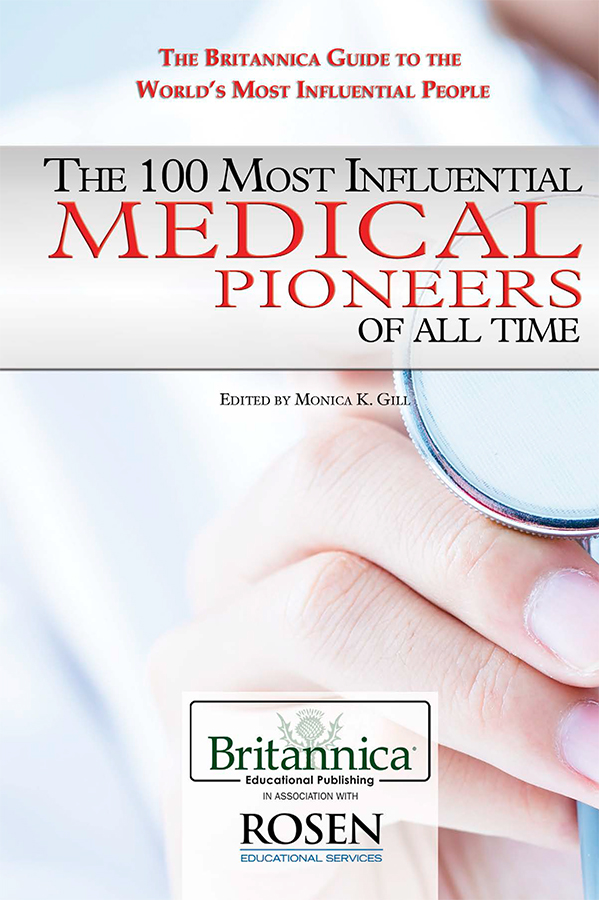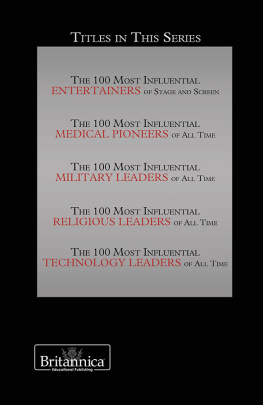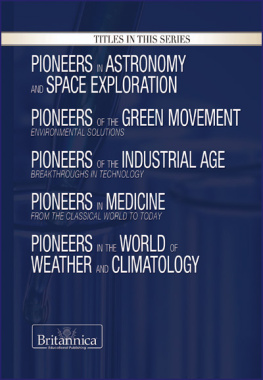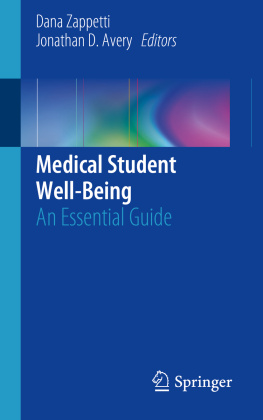

Published in 2017 by Britannica Educational Publishing (a trademark of Encyclopdia Britannica, Inc.) in association with The Rosen Publishing Group, Inc.
29 East 21st Street, New York, NY 10010
Copyright 2017 by Encyclopdia Britannica, Inc. Britannica, Encyclopdia Britannica, and the Thistle logo are registered trademarks of Encyclopdia Britannica, Inc. All rights reserved.
Rosen Publishing materials copyright 2017 The Rosen Publishing Group, Inc. All rights reserved.
Distributed exclusively by Rosen Publishing.
To see additional Britannica Educational Publishing titles, go to rosenpublishing.com.
First Edition
Britannica Educational Publishing
J.E. Luebering: Executive Director, Core Editorial
Anthony L. Green: Editor, Comptons by Britannica
Rosen Publishing
Monica K. Gill: Editor
Nelson S: Art Director
Michael Moy: Designer
Cindy Reiman: Photography Manager
Carina Finn: Photo Researcher
Library of Congress Cataloging-in-Publication Data
Names: Gill, Monica K., editor.
Title: The 100 most influential medical pioneers of all time / edited by Monica K. Gill.
Other titles: One hundred most influential medical pioneers of all time
Description: First edition. | New York : Britannica Educational Publishing, 2017. | Series: The Britannica guide to the worlds most influential people | Includes bibliographical references and index.
Identifiers: LCCN 2015034140 | ISBN 9781508100959 (eBook)
Subjects: LCSH: MedicineHistoryEncyclopedias.
Classification: LCC R125 .A13 2016 | DDC 610.3dc23
LC record available at http://lccn.loc.gov/2015034140
Photo credits:
Cover, The Asahi Shimbun/Getty Image
CONTENTS

T he practice of medicinethe science and art of preventing, alleviating, and curing diseaseis one of the oldest professional callings. Since ancient times, healers with varying degrees of knowledge and skills have sought to restore the health or relieve the distress of the sick and injured. Often, that meant doing little more than offering sympathy to the patient while nature took its course. Today, however, practitioners of medicine have several millennia of medical advances on which to base their care of patients.
Evidence of attempts to care for the sick and injured predates written records. Skulls found in Europe and South America dating as far back as 10,000 BCE have shown that the practice of trepanning, or trephining (removal of a portion of the skull bone), was not uncommon. This operation, performed by many early peoples, including American Indians, was probably done to release evil spirits that were thought to be the source of illness; yet, in many cases, it proved to be the medically correct thing to do. Opening the skull can relieve pressure and pain caused by brain tumours and head injuries.
Indeed, much of early medicine was closely identified with pagan religions and superstitions. Illness was attributed to angry gods or evil spirits; prayers, incantations, and other rituals were used to appease the gods or ward off demonsand thereby drive off disease. Nonetheless, the ancients did not entirely lack valid medical knowledge. In fact, through observation and experience, they acquired considerable wisdom about sickness and its prevention and relief.
The book of Leviticus in the Old Testament described quarantine regulations and sanitary practices that were used to prevent the spread of leprosy and plague. The ancient Romans realized the importance of sanitation to health and built sewers, systems that drained waste water from public baths, and aqueducts that provided clean water.

Galen (left), Avicenna (centre), and Hippocrates are three of the great figures of ancient medicine.
The ancient Egyptians were among the first to use certain herbs and drugs, including castor oil, senna, and opium. They also set and splinted fractured bones using techniques remarkably similar to those of modern medicine. Egyptians were reputed to be skilled diagnosticians; a medical papyrus from about 1600 BCE, which is believed to be a copy of a text from about 3000 BCE, described 58 sick patients, of whom 42 were given specific diagnoses. Although the Egyptians practiced mummification, which involved removing and dehydrating most of the internal organs of the dead, they apparently did not study those organs, as their anatomical knowledge was quite limited.
Hippocrates (460375 BCE), known as the father of Western medicine, was an admired physician and teacher who rejected the notion that disease was punishment sent by the gods; rather, he believed it had natural causes. Hippocrates put forth a doctrine that attributed health and disease to four bodily humours, or fluidsblood, black bile, yellow bile, and phlegm. He believed that the humours were well balanced in a healthy person, but various disturbances or imbalances in them caused disease. At that time, his humoural theory seemed highly scientific. In fact, doctors diagnosed and treated illnesses based on the four humours well into the 19th century.
Knowing that he could not cure most diseases, Hippocrates tended to recommend conservative measures such as exercise, rest, and cleanliness. By contrast, for fever, which he thought was caused by an excess of blood in the body, he recommended the drastic measure of bloodletting. The practice of bloodletting (or bleeding), which was thought to have many therapeutic effects, was used for more than two thousand years and undoubtedly hastened the deaths of countless patients who might otherwise have recovered.
Hippocrates is best known today for his ethical code (Hippocratic Oath), which continues to be used by the medical profession as a guide to appropriate conduct. The oath is a pledge doctors make to always use their knowledge and best judgment for the benefit of patients and to never harm or injure those in their care.
For a brief period after Hippocrates death, two Greek physician-scholars living in Alexandria, Herophilus and Erasistratus, performed the first known systematic dissections of human bodies. They dissected virtually every organ, including the brain, and recorded what they learned. Despite their dedication to the science of anatomy, these pioneers had little influence on the subsequent practice of medicine. By 150 BCE, dissection of human cadavers was banned throughout the Hellenistic world, and any writings they left behind were lost when Alexandrias library was destroyed in the 3rd century CE.
One of those trained in Hippocratic medicine was Galen (129216? CE), a Greek who traveled widely and became the most renowned physician in Rome. Although Galen accepted and embellished the four-humours doctrine, he also made important discoveries. He performed systematic experiments on animals (including apes, monkeys, dogs, pigs, snakes, and lions), which involved both dissection and vivisection (live dissection). He treated gladiators and took advantage of the opportunity to study the internal organs and muscles of the wounded. Galen recognized connections between bodily structures and functions; for example, he demonstrated that a severed spinal cord led to paralysis. He recognized that the heart circulated blood through the arteries but did not understand that it circulated in only one direction. Galen produced a prodigious body of medical scholarship that was adhered to by medical practitioners for 1,600 years. Unfortunately, his erroneous beliefs as well as his accurate insights were perpetuated.













